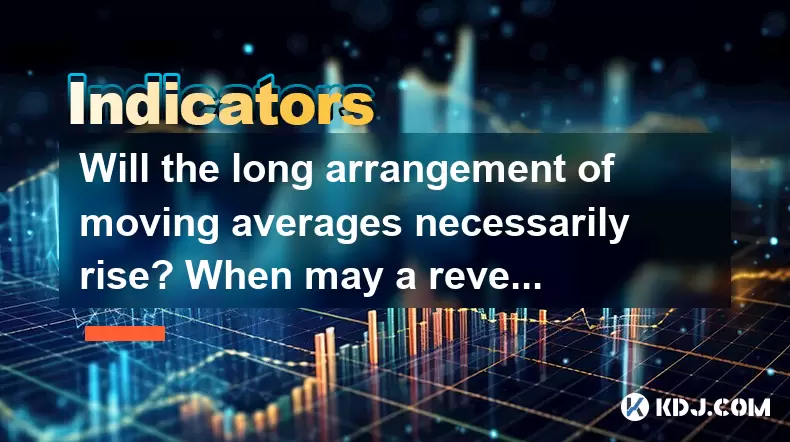-
 bitcoin
bitcoin $120167.907534 USD
1.27% -
 ethereum
ethereum $4468.611945 USD
2.53% -
 xrp
xrp $3.013607 USD
1.80% -
 tether
tether $1.000549 USD
-0.01% -
 bnb
bnb $1092.592149 USD
6.28% -
 solana
solana $231.391244 USD
4.59% -
 usd-coin
usd-coin $0.999699 USD
-0.04% -
 dogecoin
dogecoin $0.259020 USD
4.30% -
 tron
tron $0.342747 USD
0.34% -
 cardano
cardano $0.860977 USD
1.07% -
 hyperliquid
hyperliquid $50.155412 USD
5.34% -
 chainlink
chainlink $22.637678 USD
0.46% -
 ethena-usde
ethena-usde $1.000528 USD
-0.07% -
 avalanche
avalanche $30.613779 USD
-0.07% -
 stellar
stellar $0.403905 USD
0.94%
Will the long arrangement of moving averages necessarily rise? When may a reversal occur?
A long arrangement of moving averages may rise if short-term averages stay above long-term ones, but a reversal can occur with divergence or a bearish crossover.
May 21, 2025 at 01:14 pm

Will the long arrangement of moving averages necessarily rise? When may a reversal occur?
In the world of cryptocurrency trading, moving averages are a fundamental tool used by traders to identify trends and potential reversals. A long arrangement of moving averages refers to the use of multiple moving averages with different time periods, typically ranging from short-term to long-term, to analyze price movements. The question arises: does a long arrangement of moving averages necessarily lead to a rise in price, and if so, under what conditions might a reversal occur?
Understanding Moving Averages in Cryptocurrency Trading
Moving averages are calculated by taking the average price of a cryptocurrency over a specified period. For example, a 50-day moving average is the average price of the cryptocurrency over the past 50 days. In a long arrangement, traders might use a combination of short-term moving averages (e.g., 10-day, 20-day), medium-term moving averages (e.g., 50-day), and long-term moving averages (e.g., 100-day, 200-day). This setup allows traders to gain insights into different time frames and identify trends more effectively.
The Role of Long Arrangement in Identifying Trends
A long arrangement of moving averages can help traders identify the overall trend of a cryptocurrency. When shorter-term moving averages are above longer-term moving averages, it suggests a bullish trend. Conversely, when shorter-term moving averages are below longer-term moving averages, it indicates a bearish trend. However, the mere presence of a long arrangement does not guarantee a rise in price. It is merely a tool to help traders understand the current market sentiment.
Conditions for Price Rise with Long Arrangement
For a long arrangement of moving averages to potentially lead to a rise in price, certain conditions must be met. Firstly, the shorter-term moving averages must consistently remain above the longer-term moving averages. This indicates that the bullish momentum is strong and sustained. Secondly, the distance between the moving averages should be increasing, which suggests that the bullish trend is gaining strength. Lastly, the price must consistently stay above the long-term moving averages, reinforcing the bullish sentiment.
When May a Reversal Occur?
A reversal in the trend can occur under several conditions. Divergence between price and moving averages is a key indicator. If the price of the cryptocurrency continues to rise while the moving averages start to flatten or decline, it could signal a potential reversal. Another condition is the crossing of moving averages. When a shorter-term moving average crosses below a longer-term moving average, it is often seen as a bearish signal, indicating that a reversal might be imminent. Additionally, significant changes in market sentiment, such as news events or shifts in investor confidence, can lead to a reversal.
Analyzing Specific Reversal Scenarios
To better understand when a reversal might occur, let's look at specific scenarios. Scenario 1: Price Divergence. If the price of a cryptocurrency is making higher highs while the moving averages are making lower highs, this is a classic sign of divergence. Traders should be cautious as this could indicate that the bullish trend is losing steam and a reversal might be on the horizon. Scenario 2: Moving Average Crossover. When the 50-day moving average crosses below the 200-day moving average, known as the 'death cross,' it is a strong bearish signal. Traders often interpret this as a sign to exit long positions or even initiate short positions. Scenario 3: Volume Analysis. A sudden drop in trading volume during a bullish trend can also signal a potential reversal. If the price is rising but the volume is declining, it suggests that the buying interest is waning, which could lead to a reversal.
Practical Application in Trading
To effectively use a long arrangement of moving averages in trading, traders need to follow a systematic approach. Here are the steps to implement this strategy:
- Identify the Moving Averages: Choose a set of moving averages that suit your trading style. A common setup might include the 10-day, 20-day, 50-day, 100-day, and 200-day moving averages.
- Plot the Moving Averages on a Chart: Use a cryptocurrency trading platform that allows you to plot multiple moving averages on a price chart. Ensure that the moving averages are clearly visible and distinguishable from one another.
- Monitor the Arrangement: Regularly check the arrangement of the moving averages. Look for the conditions mentioned earlier, such as the shorter-term moving averages staying above the longer-term moving averages and the distance between them increasing.
- Watch for Reversal Signals: Pay close attention to potential reversal signals such as divergence, moving average crossovers, and changes in volume. Be prepared to adjust your trading strategy based on these signals.
- Backtest and Refine: Backtest your strategy using historical data to see how well it would have performed in the past. Refine your approach based on the results of the backtesting.
The Importance of Risk Management
While a long arrangement of moving averages can be a powerful tool, it is crucial to incorporate risk management into your trading strategy. Set stop-loss orders to limit potential losses, and do not risk more than you can afford to lose. Diversify your investments across different cryptocurrencies to spread the risk. Always keep an eye on the broader market trends and be prepared to adapt your strategy as needed.
Frequently Asked Questions
Q: Can a long arrangement of moving averages be used for short-term trading?A: While a long arrangement of moving averages is typically used for identifying long-term trends, it can be adapted for short-term trading by using shorter time frames for the moving averages. For example, instead of using a 200-day moving average, a trader might use a 20-day moving average as the longest term in the arrangement. However, short-term trading requires more frequent monitoring and a higher tolerance for volatility.
Q: How do different types of moving averages affect the long arrangement strategy?A: Different types of moving averages, such as simple moving averages (SMA) and exponential moving averages (EMA), can impact the long arrangement strategy. SMAs give equal weight to all prices within the period, while EMAs give more weight to recent prices. Using EMAs can make the long arrangement more responsive to recent price changes, potentially leading to earlier signals of trend changes. Traders should experiment with different types of moving averages to find what works best for their strategy.
Q: Is it possible to use a long arrangement of moving averages in conjunction with other technical indicators?A: Yes, a long arrangement of moving averages can be effectively combined with other technical indicators to enhance trading decisions. For instance, traders might use the Relative Strength Index (RSI) to identify overbought or oversold conditions, or the Moving Average Convergence Divergence (MACD) to confirm trend changes signaled by the moving averages. Combining multiple indicators can provide a more comprehensive view of the market and increase the accuracy of trading signals.
Q: How does the choice of time frames for moving averages impact the effectiveness of the long arrangement?A: The choice of time frames for moving averages significantly impacts the effectiveness of the long arrangement. Shorter time frames can provide more timely signals but may also result in more false positives. Longer time frames offer more reliable signals but may lag behind current market conditions. Traders need to find a balance that suits their trading style and risk tolerance. Experimenting with different combinations of time frames can help determine the most effective setup for identifying trends and potential reversals.
Disclaimer:info@kdj.com
The information provided is not trading advice. kdj.com does not assume any responsibility for any investments made based on the information provided in this article. Cryptocurrencies are highly volatile and it is highly recommended that you invest with caution after thorough research!
If you believe that the content used on this website infringes your copyright, please contact us immediately (info@kdj.com) and we will delete it promptly.
- BlockDAG, DOGE, HYPE Sponsorship: Crypto Trends Shaping 2025
- 2025-10-01 00:25:13
- Deutsche Börse and Circle: A StableCoin Adoption Powerhouse in Europe
- 2025-10-01 00:25:13
- BlockDAG's Presale Buzz: Is It the Crypto to Watch in October 2025?
- 2025-10-01 00:30:13
- Bitcoin, Crypto, and IQ: When Genius Meets Digital Gold?
- 2025-10-01 00:30:13
- Stablecoins, American Innovation, and Wallet Tokens: The Next Frontier
- 2025-10-01 00:35:12
- NBU, Coins, and Crypto in Ukraine: A New Yorker's Take
- 2025-10-01 00:45:14
Related knowledge

What is a tower bottom candlestick pattern? Does it have a high success rate?
Sep 22,2025 at 07:18am
Tower Bottom Candlestick Pattern Explained1. The tower bottom candlestick pattern is a reversal formation that typically appears at the end of a downt...

What is a black hole pattern in the MACD indicator? Is it a cause for concern?
Sep 21,2025 at 06:54pm
Bitcoin's Role in Decentralized Finance1. Bitcoin remains the cornerstone of decentralized finance, serving as a benchmark for value and security acro...

How can I use the psychological line (PSY) to determine market sentiment?
Sep 17,2025 at 02:19pm
Understanding the Psychological Line (PSY) in Cryptocurrency TradingThe Psychological Line, commonly referred to as PSY, is a momentum oscillator used...

How can I determine if a double top pattern has officially formed?
Sep 21,2025 at 03:18am
Understanding the Structure of a Double Top Pattern1. A double top pattern consists of two distinct peaks that reach approximately the same price leve...

What is the Golden Valley pattern on the moving average? Is it better than the Silver Valley pattern?
Sep 21,2025 at 02:54pm
Understanding the Golden Valley Pattern in Moving Averages1. The Golden Valley pattern is a technical formation observed in cryptocurrency price chart...

What does a death cross of the RSI in the strong zone (above 50) mean?
Sep 17,2025 at 10:54pm
Understanding the Death Cross in RSI Context1. The term 'death cross' is traditionally associated with moving averages, where a short-term average cro...

What is a tower bottom candlestick pattern? Does it have a high success rate?
Sep 22,2025 at 07:18am
Tower Bottom Candlestick Pattern Explained1. The tower bottom candlestick pattern is a reversal formation that typically appears at the end of a downt...

What is a black hole pattern in the MACD indicator? Is it a cause for concern?
Sep 21,2025 at 06:54pm
Bitcoin's Role in Decentralized Finance1. Bitcoin remains the cornerstone of decentralized finance, serving as a benchmark for value and security acro...

How can I use the psychological line (PSY) to determine market sentiment?
Sep 17,2025 at 02:19pm
Understanding the Psychological Line (PSY) in Cryptocurrency TradingThe Psychological Line, commonly referred to as PSY, is a momentum oscillator used...

How can I determine if a double top pattern has officially formed?
Sep 21,2025 at 03:18am
Understanding the Structure of a Double Top Pattern1. A double top pattern consists of two distinct peaks that reach approximately the same price leve...

What is the Golden Valley pattern on the moving average? Is it better than the Silver Valley pattern?
Sep 21,2025 at 02:54pm
Understanding the Golden Valley Pattern in Moving Averages1. The Golden Valley pattern is a technical formation observed in cryptocurrency price chart...

What does a death cross of the RSI in the strong zone (above 50) mean?
Sep 17,2025 at 10:54pm
Understanding the Death Cross in RSI Context1. The term 'death cross' is traditionally associated with moving averages, where a short-term average cro...
See all articles










































































